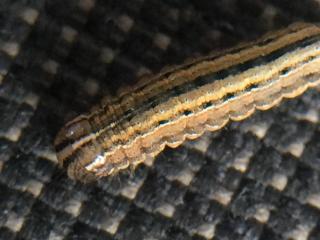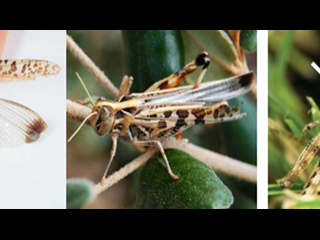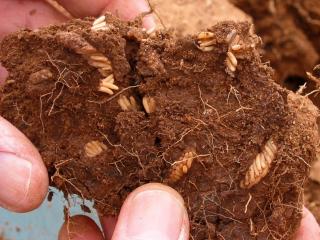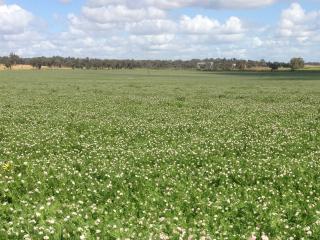Armyworm
- Belka
- York
- Greenhills
- Neridup
David Stead (Anasazi Agronomy) has recently found armyworm caterpillars in wheat at York and Greenhills, and in barley near Belka.
Nicky Tesoriero (Ceres Agronomy) has reported armyworm caterpillars causing chewing damage to wheat, prior to head emergence, near Neridup.
Growers are encouraged to monitor cereal crops for armyworm as they can defoliate plants during vegetative stages and damage heads (especially barley) later in the season during grain fill stages.

Armyworm caterpillars are fat and smooth and may be distinguished by the three parallel white stripes on the collar just behind the head. The first visible sign of armyworm caterpillars is often their green to straw-coloured droppings, about the size of a match head, found on the ground between the cereal rows.
Armyworm caterpillars are most damaging in barley crops close to harvest. When barley crops are maturing in spring, large armyworm caterpillars climb plants and can chew through the stems, causing the heads to fall to the ground. Damage to wheat and oat crops occurs less frequently and is usually minor compared to damage in barley because the stems are thicker and leaf defoliation does not usually result in yield loss. Armyworms are seldom a serious problem in pastures.
Assessing the number of armyworm in a cereal crop can be difficult, as their movements will vary with weather conditions and feeding preference. Sometimes they are found sheltering on the ground and under leaf litter whilst on other days they will be high up on the plants or on the heads, and easily picked up using sweep nets. Larger caterpillars often prefer to hide during the day and feed at night.
Growers should be mindful to distinguish recently introduced fall armyworm caterpillars from native budworm caterpillars given the incidence of budworm in cereal crops this season.
The economic level for spraying armyworm in mature barley is about three large armyworm grubs per square metre of crop. The threshold for wheat or oats is much higher as only grains are consumed and heads are very rarely dropped. Spray thresholds in these crops are more like 10 grubs per square metre of crop. For more armyworm threshold information, refer to DPIRD’s Management of armyworm in cereal crops page.
A number of effective insecticides are registered for the control of armyworm if required (see DPIRD’s 2021 Winter Spring Insecticide Guide). However, their effectiveness is dependent on good penetration into the crop. This can be difficult to achieve in high-yielding, thick canopy crops, especially when caterpillars are resting under leaf litter at the base of plants. Spraying late in the afternoon or evening is recommended as armyworm is predominately a night feeder. Spray withholding periods need to be observed.
For further information on armyworm, refer to DPIRD’s Diagnosing armyworm and Management of armyworm in cereal crops pages.
For more information, contact Technical Officer Alan Lord, South Perth on +61 (0)8 9368 3758 or Research Scientist Svetlana Micic, Albany on +61 (0)8 9892 8591.
Article authors: Cindy Webster (DPIRD Narrogin) and Dustin Severtson (DPIRD Northam).
Australian plague locust: spring hatchings are predicted
Australian plague locusts (APL) were active across grain growing areas of WA in autumn. The highest number of APL reports came in from the northern agricultural region, especially from the Beacon and Bonnie Rock. This APL activity is shown on DPIRD’s PestFax map below.
Properties that had APL in autumn are most at risk of APL hatching this spring.
Predicted hatchings
Adult APL had sufficient fat scores in autumn to lay a full complement of eggs in the WA grainbelt. High numbers of eggs can be laid in a small area, known as an egg bed, which is usually found on hard bare ground in soil that has not been cultivated, such as along fencelines and entrances to paddocks.
Eggs laid in autumn undergo diapause and hatch as temperatures warm. Over-wintering eggs do not need spring rains to hatch.
Egg beds that have been underwater can have high mortalities. However, egg beds that have been waterlogged have been observed to hatch.
Entomologist Svetlana Micic (DPIRD) has run a model to determine the predicted hatching dates for APL eggs laid in mid-April. Hatching is predicted to start from mid-August in the northern agricultural region and in mid-September in the southern region of WA. For more information see the table below.
| Locality | Predicated 2021 dates for hatchings |
|---|---|
| Allanooka | 16 August - 9 September |
| Coorow | 11 August - 7 September |
| Eneabba | 5 August - 18 September |
| Jerramungup | 14 September - 29 September |
| Kalannie | 12 August - 27 August |
| Koorda | 25 August - 8 September |
| Merredin | 31 August - 14 September |
| Moora | 27 August - 12 September |
| Moorine Rock | 27 August - 11 September |
| Mukinbudin | 23 August - 5 September |
| Scaddan | 29 August - 1 September |
| Yuna | 19 August - 2 September |
Thresholds
Pastures
Hoppers are the immature stage of APL. Hoppers take 6-8 weeks to become adults.
Hoppers and locusts can cause considerable damage to pastures. For example, 20 hoppers per square metre eat the equivalent of three sheep per hectare each day.
APL will feed on green pastures and pastures that have begun drying off. Control is considered economic if:
- Hopper densities exceed 20 per square metre and if the feeding value of pastures is equivalent to the cost of replacement feed for livestock.
- There are more than 10 APL adults per square metre.
Pastures that have completely dried off are not favoured by APL. APL and hoppers tend to move to adjacent green vegetation, such as tree lines and crops, at this stage.
Crops
Cereal crops are most susceptible to damage. Fortunately, established green crops tend to be avoided by hoppers but the edges of crops can be damaged.
Crops are most at risk when they are beginning to dry off and APL reach the flying growth stage.
The following crop stages are considered to be low risk for APL damage:
- Canola after leaf drop
- Lupins at pod bronzing
- Pulses at pod yellowing
- Completely dried off cereals.
Desiccated crops are not attractive to flying APL.
Effective control
To achieve effective control, the best time to apply an insecticide is when locusts are at the hopper stage and the majority are at the third and fourth growth stages (ie 1 to 1.3 cm long, when the wing buds are as long as the collar on the back of the head (thorax).
For insecticide information, visit the department’s Australian plague locust control: registered insecticides.
Identification

Hoppers and locusts can be easily confused with other native grasshoppers. Some grasshopper species have staggered hatchings, overlapping generations, hatch earlier than APL, and are present all year round. Grasshoppers, such as the wingless grasshopper, have more control options than APL, and other species, such as the spur-throated grasshopper, is not readily controlled by the application of synthetic pyrethroids which is registered for APL. For tips on identifying APL, refer to DPIRD’s Australian plague locust: identification field guide.
More APL information can be found at the department’s Diagnosing locusts and grasshoppers in crops and Australian plague locust: overview pages.
To read about previous APL activity this season, refer to DPIRD’s 2021 PestFax Issue 5 article Locusts are still on the move and Issue 1 article Locusts can damage emerging crops.
For more information contact Research scientist Svetlana Micic, Albany on +61 (0)8 9892 8591.
Article author: Svetlana Micic (DPIRD Albany).
Native budworm pose a threat to serradella pastures
A serradella grower recently contacted PestFax to alert all serradella growers to the threat posed by native budworm caterpillars to serradellas, particularly if they are being grown for seed.
Senior Research Scientist Clinton Revell (DPIRD) reminds growers that they should be checking their serradella pastures for native budworm caterpillars, especially in areas where plants are setting and filling pods. Native budworm is the most significant threat to serradella pastures during the seed development phase, and can cause extensive reductions in seed production. This is particularly so for French serradellas cultivars, such as Cadiz, Eliza, Margurita and Frano, and to a lesser extent the yellow serradellas, such as Santorini, Charano and Yelbini.
Earlier flowering varieties can be less impacted if pods are mature when budworms appear, but early detection is vital. Clinton says that serradellas are reasonably easy to net (unless hard grazed). If seed production is important, insecticide control is required where grubs are found (1-2 grubs per 10 sweeps) whilst the plants have green immature pods.
Small grubs found on serradellas when the pods are drying off will probably not justify control.
Along with serradella, lucerne, clover and annual medic seed crops may be attacked.
Native budworm moth trapping surveillance
- Usual automated and manual trapping locations
Most of the native budworm trappers are reporting low moth numbers. The higher numbers this week have been received from: Southern Cross (131 moths), Maya (25), Mingenew (15), Yandanooka (12), Badgingarra (10) and Kirwan (7).
Results of this week's manual trappings are available at the department’s Native budworm moth numbers 2021.
A mapped view of the native budworm trap captures is available at Cesar Australia’s MothTrapVisWA page. Viewers need to select the desired trapping date range.
Pesticide options for the control of native budworm can be found in DPIRD’s 2021 winter spring insecticide guide.
Detailed information on this pest can be found at the department’s Management and economic thresholds for native budworm.
For more information contact Technical Officer Alan Lord, South Perth +61 (0)8 9368 3758 or +61 (0)409 689 468.
Article author: Alan Lord (DPIRD South Perth).




